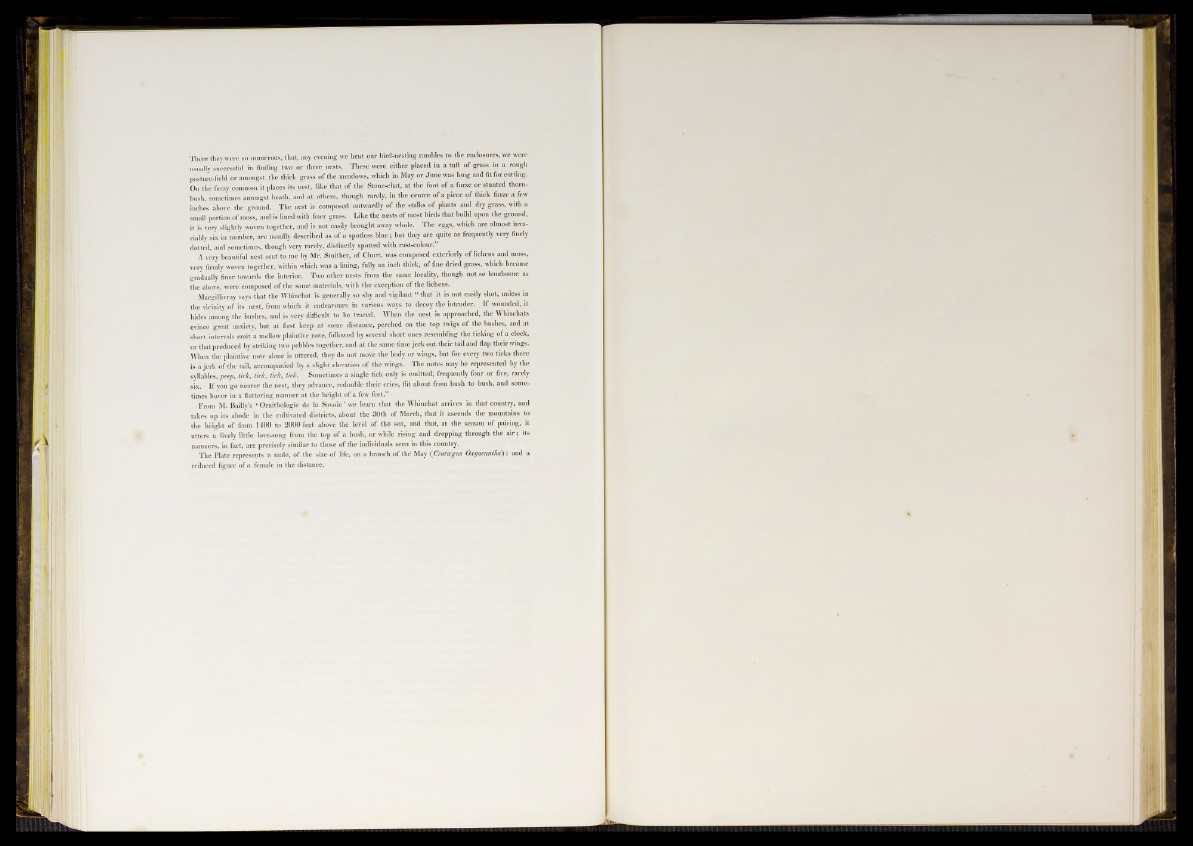
There they were so numerous, that, any evening we bent our bird-nesting rambles to the enclosures, we were
usually successful in finding two or three nests. These were either placed in a tuft of grass in a rough
pasture-field or amongst the thick grass of the meadows, which in May or June was long and fit for cutting.
On the furzy common it places its nest, like that of the Stone-chat, at the foot of a furze or stunted thorn-
bush, sometimes amongst heath, and at others, though rarely, in the centre of a piece of thick furze a few
inches abore the ground. The nest is composed outwardly of the stalks of plants and dry grass, with a
small portion o f moss, and is lined with finer grass. Like the nests o f most birds that bnild upon the ground,
it is very slightly woven together, and is not easily brought away whole. The eggs, which are almost invariably
six in number, are usually described as of a spotless b lu e ; but they are quite as frequently very finely
dotted, and sometimes, though very rarely, distinctly spotted with rust-colour."
A very beautiful nest sent to me by Mr. Smither, o f Churt, was composed exteriorly of lichens and moss,
very firmly woven together, within which was a lining, fully an inch thick, of fine dried grass, which became
gradually finer towards the interior. Two other nests from the same locality, though not so handsome as
the above, were composed of the same materials, with the exception of the lichens.
Macgillivray says that the Whinchat is generally so shy and vigilant “ that it is not easily shot, unless in
the vicinity of its nest, from which it endeavours in various ways to decoy the intruder. If wounded, it
hides among the bushes, and is very difficult to be traced. When the nest is approached, the Whinchats
evince great anxiety, but at first keep a t some distance, perched on the top twigs of the bushes, and at
short intervals emit a mellow plaintive note, followed by several short ones resembling the ticking of a clock,
or that produced by striking two pebbles together, and at the same time jerk out their tail and flap their wings.
When the plaintive note alone is uttered, they do not move the body or wings, but for every two ticks there
is a jerk of the tail, accompanied by a slight elevation of the wings. The notes may he represented by the
syllables, peep, tick, tick, tick, tick. Sometimes a single tick only is emitted, frequently four or five, rarely
six. If you go nearer the nest, they advance, redouble their cries, flit about from bush to bush, and sometimes
hover in a fluttering manner a t the height of a few feet."
From M. Bailly’s 1 Omlthologie de la Savoie ’ we learn that the Whinchat arrives in that country, and
takes up its nbode in the cultivated districts, about the 30th of March, that it ascends the mountains to
the height of from 1400 to 2000 feet above the level o f the sea, and that, a t the season of pairing, it
utters a lively little love-song from the top of a bush, or while rising and dropping through the a i r ; its
manners, in fact, are precisely similar to those of the individuals seen in this country.
The Plate represents a male, of the size of life, on a branch o f the May (Cratwgus Oxyacantha) : and a
reduced figure o f a female in the distance.